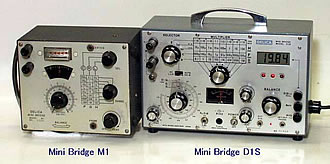| History & Topics |
| The Impedance
Bridge |
| The Impedance Bridge, sometimes called as “universal bridge”
measures Resistance (R), Capacitance (C) and its Dissipation factor
(D), Inductance (L) and its Quality factor (Q) separately by audio frequency
such as 1 kHz. “Impedance” is a genetic term of R,C and L. The automatic
digital instruments such as LCR meters are popular now, but the impedance
bridges are still in use today due to their merits. The basic principle of an impedance bridge is similar to the principle of a balance comparing unknowns with their built-in standards. The balance is established by adjusting the balancing arm manually. Since the accuracy of the balance (hence the bridge) depends on a stability of built-in standards, the accuracy lasts long. Various types of bridges have been used for the maintenance of national impedance standards until modern sophisticated equipments have developed. |
 |
| We have been producing vacuum tube type bridges soon after the WW2. Tiny, but great transistors expelled tubes and squeezed the desktop gears to palm-size machine. Ultra compact, wide range, high accuracy and inexpensive Mini Bridge M1s have put on sale in 1964. Quite a few of them have been sold since then and some are still in use today. The latest and high-end model Mini Bridge D1S (basic accuracy: 0.2%) employs digital display for the read-out of balancing arm and DQ dials instead of analog scale. Also adopted are LED lamps showing the direction you turn the knob to make balance. D1S is already a 20 year long-seller. Our policy to use common parts for our products helps long-term service available. The perfect restoring of your Mini Bridge M1 is still possible if the physical structure and balance potentiometer are intact. |
| History & Topics - INDEX |
| DELICA MITA MUSEN KENKYUSHO LTD |